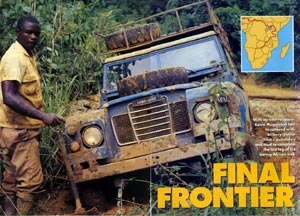
Final
Frontier, Landrover Owner Magazine
With
no time to spare, Kevin Muggleton has to contend with bribery,
police checks, punctures and mud to complete the last leg of his
daring African trek
Midway
through my trans-Africa route, I drove into Ghana with the Land
Rover shuddering violently over every pothole I hit - the steering
ball joints were shot. After 7000 miles on the road, many of them
so rough they could barely be recognised as tracks, the steering
had taken such a hammering it was inevitable something would give.
The carburettor was also continuing to cut the engine at low revs.
Shopping for parts in Accra provided all the new spares I needed
at very reasonable prices, and after only two days work the Land
Rover was back to its old self.
As I headed east, swallowing whole countries at a time - Ghana,
Togo and Benin - I vowed I wouldn't travel through Nigeria
after dark, and promised myself to avoid the capital Lagos at
all costs. But after I'd been questioned at the border for five
hours by the drug squad and the ugly secret police, and delayed
by 50 or more separate check points after the border, I ended
the day driving the streets of Lagos. The set for the film Blade
Runner must have been modelled on this city.
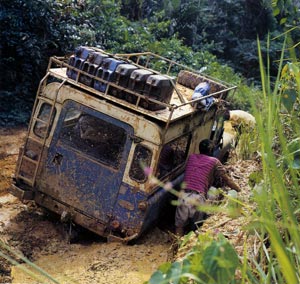
Above,
it could take up to five hours to dig the Land Rover out of holes
like this - even with local hired help. On the worst sections,
Kevin was managing to travel only 4km a day
There were burst water mains, flooded roads and, with no street
lights, vehicles crawling like leviathans through the dense diesel
fumes. Spotting my foreign plates, a gang in one car lurched across
my path but they were soon shifted as the Land Rover pushed them
off the road. In the most crime-ridden city in Africa, this was
no place to gamble on what their intentions might have been.
Lagos set the mood for the whole country and confirmed that Nigeria
had fallen into lawlessness. Motorists, harassed by the frequent
roadblocks, passed over handfuls of cash. Corruption was so rife
I was threatened with everything, from violence to imprisonment,
to convince me to hand over money. With ill-feeling, I stopped
to sleep and refuel, taking advantage of Africa's cheapest petrol
at 11 pence a litre. Finding the fuel was a different story, but
when I did, I filled every tank and jerrycan to capacity before
leaving the country.
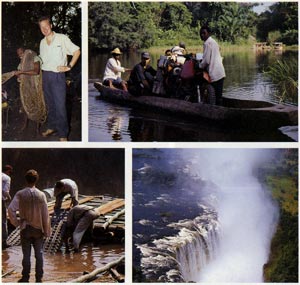
Clockwise
from top left, 6ft 3in author with the tallest of a Pygmy tribe
how to get a bike across a river; splendour of the Victoria Falls;
building a raft to carry the Land Rover
Driving through the Central African Republic and Cameroon, luck
was with me because I had missed the tail end of the rainy season
by just two weeks. Vehicles travelling during the rains make it
a costly business to repair the heavily damaged tracks, so officials
close rain barriers along the major routes to prevent any further
erosion.
The Ubangi River forms the border between the Central African
Republic and Zaire. Along the river, the lowland region is a mosquito-ridden,
steamy climate and it was here that I succumbed to my first bout
of malaria. I was racked with fever and vomiting. Treatment was
a simple course of prophylactics and antibiotics but afterwards
even the simple task of changing a wheel became a momentous chore.
To conserve energy for the heavy mud sections ahead, I cut the
driving days to about five hours.
The Amazon of Africa, Zaire has the second largest rainforest
in the world and is larger than western Europe. Accompanied by
a violent uprising, independence came in 1959 and since then there
has been no investment in communications or roads. Heavy annual
rains have meant that roads built during the colonial era have
been washed away. Politically, the country is a mess as President
Mobuto has developed a feudal system to dispel attempted coups.
Even finding an open border post is difficult. I wasted valuable
fuel on many detours searching for a crossing point that hadn't
been closed.
Finally it was far along the border at Bangassou that I found
a crossing point. To enter Zaire I initially took a pirogue (a
dugout canoe) across the river in search of the barge operator.
It was here I met some Belgian and Dutch travellers and together
we negotiated for two days with border officials before they eventually
let us through. Withnowhere else to cross, negotiations were a
slow process as I went through the finer tax charges. In hindsight,
the road tax was a scam, as I found nothing that could be classed
as a road.
The tracks in the drier northern Zaire were the least damaged
but you still needed your wits about you. Rivers crossed the tracks
repeatedly, and the makeshift bridges, made from fallen trees.
were precarious. It pays to take your time over these - I didn't
always and twice a wheel slipped off, leaving the Land Rover dangerously
perched on the edge.
Without warning, the new relay unit I had purchased in Ghana snapped.
There was no welding equipment anywhere nearby to repair it, but
luck favoured me because hidden nearby in anovergrown mission
was a non working Land Rover with the very part I needed. After
making a £40 donation to the local church I had; the old
part removed and was my way the same day.
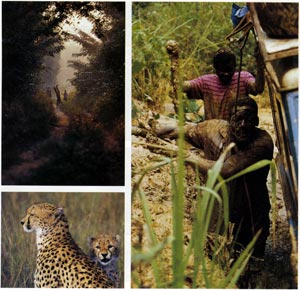
Clockwise
from-top, main forest tracks are busy with foot traffic during
the day on clearing a mud hole is like emptying a swimming pool
with a shovel; Cheetahs on the open plains
I predicted the route would deteriorate as I pushed further south
and I wasn't disappointed. The small ferry I had planned to cross
the Bili River on had been sunk by the drunken operator four months
earlier. With my new-found Continental friends, we begged and
borrowed oil drums, collected our spare inner tubes together and,
within two days, had built a raft strong enough to float us across
the slow-moving river. This was very much the pattern of things
to come.
Moving south through Isiro and Wamba, the route took me deep
into the rainforest. Here, even during the so-called dry season,
it rained daily and I entered the most appalling area I have ever
driven.
The Land Rover immediately plunged into a quagmire of reddish-brown,
wet, sticky clay. Three hours digging later and within minutes
I had driven headlong into another -there was no escape. The track
was walled in by rainforest, with no chance of a detour; the mature
trees were wider than the Land Rover was long. Friendly villagers
appeared and stared in amazement at seeing a white man for the
first time in ages. The mood quickly switched to astonishment
and then incredulity at my ludicrous form of transport. Here they
had long ago switched to bicycles, which are four times faster
than any motor vehicle.
Three weeks into Zaire and I was nowhere near where I needed to
be. At times I was hiring up to 25 Africans to help dig, shove
and cut a way through the rainforest. In hindsight, five more
shovels would have helped. Even walking through the potholes to
gauge the depth was no guarantee of success.
Although I was weighed down by a full fuel load, at least the
jerrycans could be unloaded: a huge benefit over using extra fixed
tanks. Driving was a test of nerves as, to avoid grounding the
diffs, I had to climb the wheels onto the central ridge at a precarious
angle. Driving like this for two kilometres at a time forced the
vehicle against the mud banks, chiselling the side, smashing the
lights and denting every inch of bodywork.
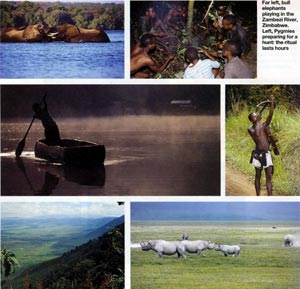
Centre
left dugout canoes cross the rivers from dawn to dusk. Above centre,
hunters live deep in the rainforest. a Above, wildlife in the
extinct Ngorongoro crater (left )
First
and reverse gears in low ratio were the only gears I used, pausing
for up to five hours to dig and scoop the vehicle from one hole
to the next. This routine continued daily for up to 12 hours.
Questioning how the route fared ahead proved futile as the villagers
had had no experience of driving. Some days I covered only four
kilometres, but on good days I managed over 20. At least the slow
pace allowed me to appreciate the surrounding kaleidoscope of
colours and some of the friendliest people I've ever met.
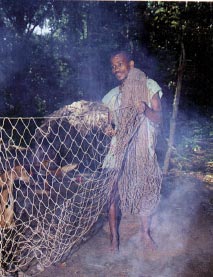 Left, readying the nets before a hunt. Left, readying the nets before a hunt.
The Pygmies I visited had spumed all attempts to integrate them
into modem life. Living a raw and primitive lifestyle, deep in
the rainforest, they used poisoned darts and spears to hunt and
built huts from leaves; they even used plants for medicine. Off
the beaten track, the Land Rover wasn't an option. The forest
was thick with primary and secondary growth trees, and I had a
brief glimpse into their lives.
After leaving the Pygmies 1 focused on driving out of the mess
and into Uganda. Four hours along the cratered track to Mambasa,
I found a Toyota Landcruiser stuck in the ruts and blocking the
route. With no room to turn around and use the heavy-duty military
towing hook, I wrapped the chain around my front bumper. As the
Toyota slowly lifted from the mud, my chassis broke above the
left wheel -but fortunately not all the way through. Then, while
avoiding holes as best I could, a branch smashed through the passenger
window and took the door clean off at the hinges.
I found a fully equipped Catholic , mission in Mambasa and the
priests set their apprentices at cleaning up the break and welding
a box section around the chassis. Again, an old Series III came
to the rescue as I relieved it of its door. The window was missing
so, for security, sheet steel plate was made to fit.
Below,
bicycles are quicker than any motor vehicle in Zaire. Below left,
it's easy to get lost in the forest where the Pygmies live.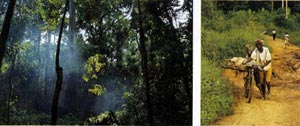
The Land Rover was complaining by the time I hit the tar roads
of Uganda. It was in need of a major overhaul. With the thick,
caked mud washed off, the extent of damage caused through Zaire
was visible. Beneath the window line, bare, crumpled aluminium
was revealed, with little paint to speak of. The headlight surrounds
had caved in and the chassis, after repair, was sitting at an
uncomfortable angle. The clutch snatched, it was difficult to
engage low gears, the gearbox had a deafening whine and I donated
the mangled roof rack to my next host.
But I still needed to drive 4000 kilometers, via the Ngorongoro
crater in Tanzania, to reach Victoria Falls in southern Africa.
Driving through East Africa is usually a doddle, but driving it
with threadbare tyres was a nightmare. Police vehicle checkpoints
abounded and it took a swift tongue to talk my way past each point.
With the end of the trip in sight, the last thing I wanted to
invest in was another set of tyres.
Puncture stops frequented the long roads through Zambia. The police
rarely see a Land Rover in such poor condition and, in sympathy,
turned a blind eye. Three hundred kilometres north of Lusaka,
the back left tyre blew out -the tread had finally worn through.
The inner tubes on the remaining tyres were so badly punctured
that
Even the repairs were wearing out. Realising I wouldn't make it
the whole way, I bought a new tyre in the first town I reached
and was stung with a bill for £200.
Driving across the bridge between Zambia and Zimbabwe, the refreshing
spray of Victoria Falls soaked the vehicle and I still had a week
before my flight back to the UK. Twenty thousand miles and five
months after starting out, the Land Rover was a write-off by UK
standards. So I left the Landrover with a friend in Zimbabwe.
He has since replaced the tyres, beaten out the bodywork, rewelded
the chassis, overhauled the gearbox and has just returned from
a trouble-free adventure around Botswana and the Namib Desert...
My next major drive will be from Argentina to Alaska, and you
can count on me searching out one of Solihull's ageing finest
to stand up to the task.
|